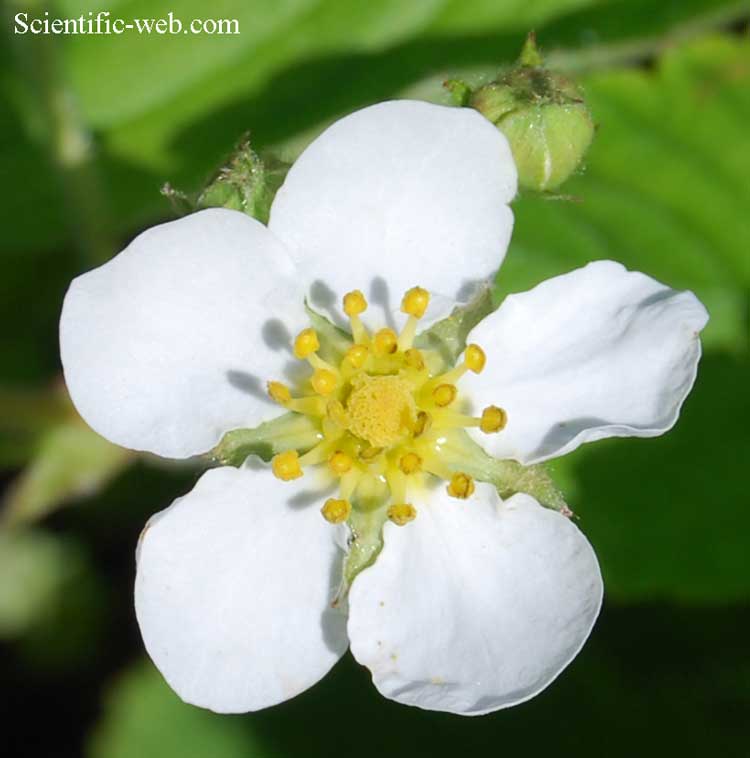
Fragaria moschata, Photo: Michael Lahanas
Classification System: APG IV
Superregnum: Eukaryota
Regnum: Plantae
Cladus: Angiosperms
Cladus: Eudicots
Cladus: Core eudicots
Cladus: Rosids
Cladus: Eurosids I
Ordoo: Rosales
Familia: Rosaceae
Subfamilia: Rosoideae
Tribus: Potentilleae
Subtribus: Fragariinae
Genus: Fragaria
Species: Fragaria moschata
Name
Fragaria moschata Weston, Bot. Univ. 2: 327. 1771 (A. N. Duchesne, Hist. nat. frais. 145. 1766, nom. inval. as "races principales").
Synonyms
Homotypic
Fragaria elatior var. moschata (Weston) Sm. in Rees, Cycl. : 15, n° 4.a. 1810.
Fragaria vesca moschata Desf. in Cat. Pl., 294. 1829.
Potentilla moschata (Weston) Prantl, Excurs.-Fl. Bayern. : 346. 1884.
Heterotypic
Fragaria elatior Ehrh., Beitr. Naturk. 7:23. 1792., nom. illeg.
Fragaria elatior var. magna (Thuill.) Mutel, Fl. Franç., 1: 329. 1834.
Fragaria grandiflora Chevall., Fl. Gén. Env. Paris, 2: 708. 1827, nom. illeg. non Crantz (1766).
Fragaria magna Thuill. in Fl. Paris, 254. 1799.
Fragaria moschata dioica Duchesne in Lam., Encycl. méth. vol. 2, 536. 1790.
Fragaria moschata f. rubiflora Heimerl in Abh. Zool. u. Bot. Ges. Wien vol. 31, 176. 1881.
Fragaria muricata Mill., Gard. Dict., ed. 8 : n° 3. 1768, nom. illeg. non L. (1753).
Fragaria pratensis (L.) Duchesne in Lam. Encycl. Méth. Bot., 2: 536. 1788.
Fragaria reversa Kitaibel, in Linnaea vol. 32, 595. 1863.
Fragaria vesca subsp. elatior (Thuill.) Bonnier & Layens, Fl. Fr. : 100. 1894.
Fragaria vesca var. elatior Thuill., Fl. Env. Paris, éd. 1: 172. 1790.
Fragaria vesca var. magna (Thuill.) DC. in Lam. & DC., Fl. Franç., éd. 3, 4 (2) : 468. 1805.
Fragaria vesca var. pratensis L., Sp. Pl., éd. 2: 709. 1763, nom. superfl.
Fragaria vesca var. pratensis Aiton in Hort. kew., 211. 1789.
Fragaria zapateriana Pau, Not. Bot. Fl. Esp., 3: 18. 1889.
References
Botanicus Universalis 2: 327. 1771.
USDA, ARS, Germplasm Resources Information Network. Fragaria moschata in the Germplasm Resources Information Network (GRIN), U.S. Department of Agriculture Agricultural Research Service.
Tela Botanica (2000-2009). Le réseau des Botanistes Francophones. Accessed 2009 Jul 30 [1]
Vernacular names
azərbaycanca: Ətirli çiyələk
беларуская: Клубніцы
буряад: Зэдэгэнэ
čeština: Jahodník truskavec
Cymraeg: Llwyn Mefus Mawr
Deutsch: Moschus-Erdbeere
dolnoserbski: Wusoka słynica
English: Hautbois Strawberry
español: Fresa almizcle
eesti: Kõrge maasikas
suomi: Ukkomansikka
français: Fraisier musqué
hornjoserbsce: Wysoka truskalca
日本語: シロバナヘビイチコ
ქართული: ხენდრო
қазақша: Құлпынай
lietuvių: Muskusinė braškė
кырык мары: Кого мӧр
Nederlands: Grote bosaardbei
Ирон: Галы æрыскъæф
polski: Poziomka wysoka
português: Morango musk
русский: Земляника мускусная
slovenčina: Jahoda drúzgavicová
slovenščina: Muškatni jagodnjak
српски / srpski: Јагода китињача
svenska: Parksmultron
удмурт: Мускусной узы
українська: Суниці мускусні
The musk strawberry or hautbois strawberry[2] (Fragaria moschata), is a species of strawberry native to Europe. Its French name hautbois strawberry may be anglicised as hautboy strawberry.[3] The plants are hardy and can survive in many weather conditions. They are cultivated commercially on a small scale, particularly in Italy. The fruit are small and round; they are used in the gourmet community for their intense aroma and flavour, which has been compared to a mixture of regular strawberry, raspberry and pineapple.[4] Popular cultivated varieties include 'Capron' and 'Profumata di Tortona'.
Distribution
Leaves
Musk strawberries grow wild to a limited extent in the forests of Central Europe, north into Scandinavia, and east into Russia.[5] The musk strawberry is found growing along the edges of forests and requires moist and sheltered sites since they do not tolerate temperature fluctuations.
Polyploidy
All strawberries have a base haploid count of 7 chromosomes. Fragaria moschata is hexaploid, having six pairs of these chromosomes for a total of 42 chromosomes.
Cultivation
Musk strawberry has long been in cultivation in parts of Europe. This species was the first strawberry of any sort with a cultivar name, which was Le Chapiron (1576).[4] By 1591, the cultivar was called Chapiton, then later Capiton. In the early 17th century an illustration appeared in the Hortus Eystettensis as fraga fructu magno. It was mentioned by Quintinye, gardener to Louis XIV, as Capron in 1672.[4] At the beginning of the 19th century musk strawberries were the most common garden strawberry in Germany.[6]
Cultivation of musk strawberries is similar to that of garden strawberry (Fragaria × ananassa) or alpine strawberry (Fragaria vesca); the plants thrive in nutrient-rich soils. However, neither female plants nor hermaphrodite plants are self-fertile; they require pollen transfer from a male or a different hermaphrodite clone (or cultivar) of the same species, which is usually achieved by insect pollinators.[6]
Cultivars:
'Capron royal', hermaphrodite
'Askungen' (Truedsson) hermaphrodite
'Marie Charlotte' (Hans) hermaphrodite
'Bauwens', female
Fragaria moschata 'Capron', female
'Profumata di Tortona', female
'Siegerland', female
'Cotta', male
Notes
"The Plant List: A Working List of All Plant Species". Retrieved 3 October 2014.
BSBI List 2007 (xls). Botanical Society of Britain and Ireland. Archived from the original (xls) on 2015-06-26. Retrieved 2014-10-17.
Karp, David. "Berried Treasure". The Smithsonian Magazine. Retrieved 2012-01-28.
Reich, Lee (2004). Uncommon Fruits for Every Garden. Timber Press. pp. 34–35. ISBN 0-88192-623-X.
Goodyear, Dana (14 August 2017). "Strawberry Valley". The New Yorker. Retrieved 16 August 2017.
Wachsmuth, Brigitte: Von Monats-, Wald- und Moschuserdbeeren 20-28. In: Gartenpraxis 35 4/2009
Retrieved from "http://en.wikipedia.org/"
All text is available under the terms of the GNU Free Documentation License

